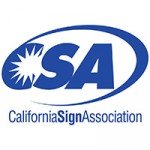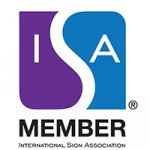Month: November 2017
Best Sign Company for Public Works Projects
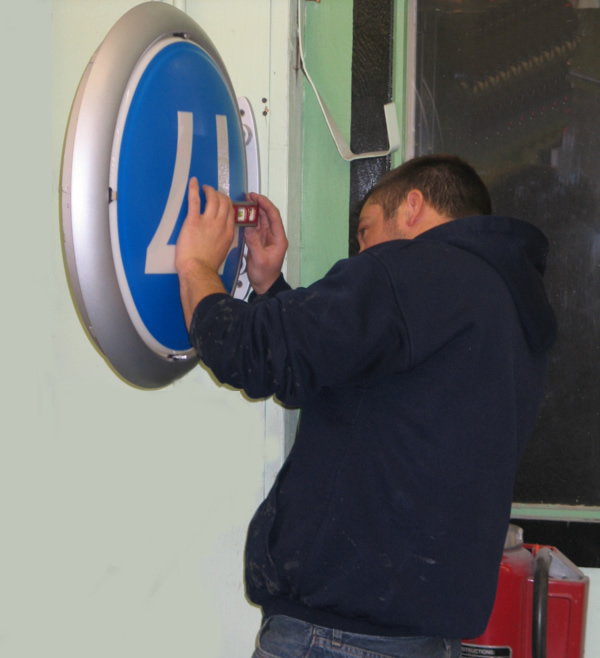
As the transportation needs of the nation’s largest cities continues to expand, their public works projects get bigger and bigger. Over the years, CNP Signs & Graphics has shown itself able to take on these large-scale projects [ie. signage for Los Angeles International Airport (LAX) and San Diego International (SAN)]. Today we are positioned for even bigger projects.

Large projects such as LAX and LA Metro (Blue Line) oftentimes require their subcontractors (including sign companies) to have specifically trained and certified work forces. For instance, LAX required background checks to allow installers to work in CBP sensitive areas. The LA Metro project required extensive training for working on/around live trains. Having workers who have gone through this process and are familiar is a big advantage as the learning curve is not quite as steep.
While there are a few large scale sign companies in the US, there aren’t many here in California. CNP Signs & Graphics has a highly-skilled work force large enough to handle the scope of signage the largest public works projects often demand. Smaller companies simply don’t have the production capabilities to quickly and effectively produce the sheer volume of signs in the time allotted. Of course, manpower isn’t the only factor. Our experience in the industry is first and foremost. Having been in business since 1939 (and owned by the same family), we’ve been building signs for over 70 years now.
In the past, CNP has been awarded a lot of the custom projects from local design firms. These were comprised, for the most part, of smaller projects (businesses, parks, smaller public spaces like hospitals, etc.). However, over the past 15 years as we’ve completed much larger projects, we’ve started garnering attention from the elite contractors. National firms (such as McCarthy, Kiewit/Sundt and Walsh/Austin) now seek out companies with special skill, capabilities and experience such as CNP to complete their project signage.
Our successful completion of very large projects, like LAX International, has prompted large construction companies to invite CNP to participate in even more public works bidding processes. Combining our large scale, public works projects with our smaller scale, design firm driven experience, CNP is ready for the future of public works projects.
Murals of La Jolla


Public art on a grand scale now accentuates the natural beauty of the La Jolla Cove and other locations in the downtown area of this tony beachside community. “Brain Cloud” and “53 Women”, the 4th and 5th art pieces of the series, have recently been installed as part of an effort to beautify and bring attention to the arts by the La Jolla Community Foundation.
The Murals of La Jolla project is the most visible enterprise for the Foundation, whose charter directs them toward “improving the atmosphere, ambience, and cultural lifestyle of La Jolla”. The scope for Murals of La Jolla encompasses up to 12 large format art pieces either painted directly on the walls of local businesses, or printed and stretched across frames erected on the buildings. The remainder of the art projects will be installed over the next year in the La Jolla business area.
Installation of these very large pieces (Brain Cloud, by John Baldessari for instance is 36 ft. by 40 ft.) was a challenge for CNP Signs & Graphics, the San Diego-based firm that provided the expertise for printing and installing the pieces. Instead of simply hanging a printed banner, the art is being stretched across aluminum frames that hold the 15 oz. vinyl taut, flattening the artwork and creating a more finished look.
A normal building installation would not be a problem for the 7o year-old sign manufacturing and design firm, but access to the building was restricted to a steep staircase coming up from the La Jolla Cove. The 40-foot roll of canvas weighing nearly 600 pounds needed to be man-handled from street level up the staircase before it could be attached to rooftop hauling systems that lifted the canvas into place.
Artist Baldessari, whose roots are here in San Diego, created the whimsical “Brain Cloud” which pictures a floating brain-shaped cloud over an idyllic San Diego beach scene. His intention was to create a shift to our perceptions of the world around us.
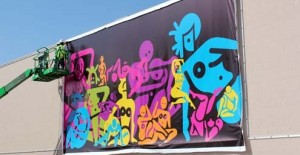
Both “Brain Cloud” and “53 Women” are printed on vinyl and then stretched over aluminum frames installed on the building sides. The frames will remain in place over time, but according to the La Jolla Community Foundation, the pieces themselves may change as new works are commissioned.
The frames installed by CNP Signs & Graphics will endure for some time as they are made of extruded aluminum and painted with Matthews Acrylic Polyurethane to protect the system from harmful UV rays and corrosion. This protective coating means the frames can survive maintenance free for years, if not decades.
For more information on the art installations, visit the Murals of La Jolla website. For more information on public art projects, signs and sign installation, contact CNP Signs & Graphics.
LA Drops Plans to Tighten Restrictions on Business Signs
LA businesses and the signs industry have won an important fight against harsh restrictions and fines considered by the City of Los Angeles, reports the Los Angeles Business Journal this morning. The rules were considered by many business owners to be excessive – fines for a violation of a sign measuring 20 x 20 were proposed to be $6,000 for the first violation, $12,000 for the second, and $24,000 for the third.
Instead the city is considering a proposal from business groups and the sign industry to levy a fee on all business owners with sign permits. The money would go to hire more inspectors to target thousands of business signs without permits, writes the Journal.
As we noted in the CNP Signs & Graphics blog months ago, the changes proposed by the City were highly restrictive. “The City of Los Angles wanted outdoor pole signs reduced from 42 feet to 25 feet,” says Roy Flahive of CNP Signs & Graphics, a national sign company located in San Diego, CA. “The signage allotment for a piece of property would have been reduced from 4 sq feet to 1 sq foot, per lineal foot of frontage, and it would have reduced monument signs by half.”
The new fees levied against businesses with legal signs will go toward hiring new inspectors. These inspectors will be targeting the large number of illegal signs in the City. Some estimates of illegal signage are up to 50% of all signs in the incorporated area. Business groups and anti-sign activists can agree on one thing – the illegal signs add to the problem of clutter and excessive ambient light.
Jack in the Box Re-Image Installations
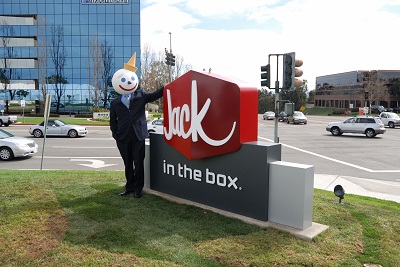

Jack in the Box is currently re-imaging and modernizing their exterior signage program to become more current and contemporary. These new signs started appearing in late 2008, and became the norm in 2010. Jack in the Box corporate worked closely with their designers and CNP Signs & Graphics to produce a look that was innovative and hip while keeping recognizable elements of the brand for the Jack consumer and allowing for rapid roll-out among their multiple national locations.
Jack in the Box, with over 2,100 locations in 18 states, has launched several new logo designs over the life of the company, averaging nearly one every ten years. CNP Signs & Graphics has been involved with each re-imaging project over their 60 year history with Jack in the Box and is proud to consider themselves a partner of such an evolving company.
Not only has Jack corporate strived to update the exterior look of the signs, they’ve also updated the materials used to make them. One major step included moving away from older illumination technology and ‘going green’ with the adoption of new, long-life Tri-Phosphor lamps to illuminate the ground signs and building signs. These lamps have a lifetime of approximately 5 – 7 years running at 8 hours a day (which is roughly 40% more efficient than the old standard fluorescent bulbs). The money businesses save on service calls alone makes these lamps cost-effective, as well as environmentally friendly. The tri-phosphor lamps are a relatively new product, and reflect both Jack in the Box’s and CNP Signs’ ability to keep up with new technology. In fact, CNP Signs & Graphics is one of the first major programs nationwide to use these lamps.
Jack in the box has always offered customers distinctive and innovative products, so why should their signs be any different? As they stay on the cutting edge of the quick service industry, CNP Signs & Graphics continues to work closely with them to make sure the re-image and store openings are completed on time. Next time you are by a Jack in the Box check out the K in the new logo. Doesn’t it remind you of a certain someone’s smile? Jack maybe?
Title 24 Green Standards for Sign Industry
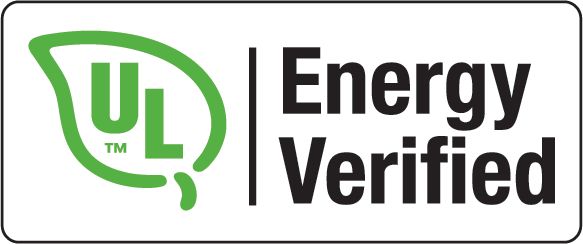

UL, an independent, not-for-profit product safety testing and certification organization, working with the California Energy Commission (CEC) and sign industry representatives, including Roy Flahive from CNP Signs & Graphics, has developed a program for sign manufacturers to demonstrate compliance with the energy conservation requirements within Title 24, of the California Energy Commission’s Building Energy Efficiency Standards.
CNP Signs & Graphics is currently one of only six companies nationwide to utilize these new building standard certifications. “A sign that costs less for our customers to maintain will always be a win for our company as well,” says Bob McCarter, Vice President of CNP Signs & Graphics. “Verified certification from UL is a great way to show our commitment to producing green signs for this growing market.”
The CEC adopted sign lighting regulations on January 1, 2010. The requirements for signs can be found in the 2008 Building Energy Efficiency Standards, Title 24, Part 6, Section 148 of the California Code of Regulations.
The published sign lighting standards address both indoor and outdoor signs, and include mandatory automatic control requirements for all illuminated signs. In addition, the standards set limits on installed lighting power for internally and externally illuminated signs. There are two alternate methods to comply with the 2008 sign lighting standards.
• Watts per square foot – sets maximum power per sign area
• Specific Technology – uses only energy efficient lighting technologies
UL48 sign manufacturers now have the option to apply the UL Energy Verified Mark to signs that demonstrate compliance to one of the lighting power alternatives described above in lieu of having a licensed contractor perform the evaluation on each sign. The UL Safety Mark and the UL Energy Verified Mark will always appear together on signs covered under this new program.
History Repeats Itself – A New Movie Marquee for a Classic Theater
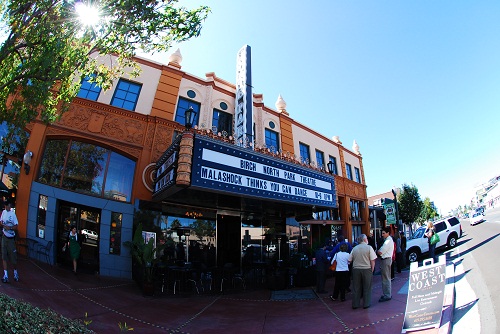
Popcorn did not cost $8.50 when the Birch North Park Theatre opened in 1928. You could not buy your tickets online. But if you gaze up at the vertical marquee sign illuminating the newly refurbished movie palace today, you’d need a keen eye to spot the differences to the original sign that was hung 82 years ago.

For one thing, the original sign was built from standard sheet metal. The new sign, built by CNP Signs & Graphics in San Diego, is made from aluminum, which in those days was reserved for more high-tech items – like Charles Lindbergh’s propeller on the Spirit of St. Louis. Standard sheet metal is prone to deterioration due to moisture. This is likely the reason the original sign was finally taken down.
Also new (and tough to spot from street level) is the paint used in the new construction. The new sign is painted with Linear Polyurethane paint, which was also not available in the 20’s. Both the aluminum structure and the paint utilized on the new sign will enable it remain in use for many years, basically maintenance free.
The new sign is also significantly safer. The transformer used to illuminate the neon on the West Coast lettering, is energy efficient as well as being much safer than those used in the twenties. 15,000 volts going to ground can really ruin an otherwise pleasant outing to the movies. The new, high-voltage transformer has integrated secondary ground fault protection. Should the high voltage accidently go to ground, the transformer will turn off automatically.
Manufacturing and installing a historic replica involves more than simply securing a building permit. Special permission for construction – verifying the sign was as close a replica as possible to the original sign – required compliance with the Secretary of Interior’s Standards for Reconstruction as well as approval by the San Diego Historic Review Board.
As a 71-year-old sign company run by the fourth generation owners, CNP Signs & Graphics was especially suited to undertake such a project.
“We understood the amount of pride and ownership the community places on this project. It’s not just a movie marquis. It represents heritage and civic pride” says Bob McCarter, Vice President of CNP Signs & Graphics.
“This sign identifies more than the North Park Theatre, it identifies the community of North Park; in that regard we had a responsibility to copy the original sign as closely as possible, while also integrating the latest and best materials for longevity, low maintenance and reduced energy consumption.”
The original sign was illuminated with incandescent light bulbs which were the only source of sign illumination along with neon in 1928. The Theatre operators wanted the new sign to be as energy efficient as possible. The neon units illuminating the neon lettering reading West Coast were energized by a highly efficient neon power supply. Additionally, the incandescent light bulbs (11watts in the perimeter and 7watts in the letters) were replaced with LED bulbs that cut energy use by more than 300%. In fact, the total energy savings in a year – assuming five hours of having the marquis lit each night – 365 days a year – would equal over 13 million watts of power. The savings on the Theatre’s energy bill is over $3,000.00 per year.
It’s true they don’t build them like they used to. Sometimes they build them better.
(To see the lighting ceremony for the new Birch North Park Theatre, click here.)
History Repeats Itself – A New Movie Marquee for a Classic Theater

Popcorn did not cost $8.50 when the Birch North Park Theatre opened in 1928. You could not buy your tickets online. But if you gaze up at the vertical marquee sign illuminating the newly refurbished movie palace today, you’d need a keen eye to spot the differences to the original sign that was hung 82 years ago.

For one thing, the original sign was built from standard sheet metal. The new sign, built by CNP Signs & Graphics in San Diego, is made from aluminum, which in those days was reserved for more high-tech items – like Charles Lindbergh’s propeller on the Spirit of St. Louis. Standard sheet metal is prone to deterioration due to moisture. This is likely the reason the original sign was finally taken down.
Also new (and tough to spot from street level) is the paint used in the new construction. The new sign is painted with Linear Polyurethane paint, which was also not available in the 20’s. Both the aluminum structure and the paint utilized on the new sign will enable it remain in use for many years, basically maintenance free.
The new sign is also significantly safer. The transformer used to illuminate the neon on the West Coast lettering, is energy efficient as well as being much safer than those used in the twenties. 15,000 volts going to ground can really ruin an otherwise pleasant outing to the movies. The new, high-voltage transformer has integrated secondary ground fault protection. Should the high voltage accidently go to ground, the transformer will turn off automatically.
Manufacturing and installing a historic replica involves more than simply securing a building permit. Special permission for construction – verifying the sign was as close a replica as possible to the original sign – required compliance with the Secretary of Interior’s Standards for Reconstruction as well as approval by the San Diego Historic Review Board.
As a 71-year-old sign company run by the fourth generation owners, CNP Signs & Graphics was especially suited to undertake such a project.
“We understood the amount of pride and ownership the community places on this project. It’s not just a movie marquis. It represents heritage and civic pride” says Bob McCarter, Vice President of CNP Signs & Graphics.
“This sign identifies more than the North Park Theatre, it identifies the community of North Park; in that regard we had a responsibility to copy the original sign as closely as possible, while also integrating the latest and best materials for longevity, low maintenance and reduced energy consumption.”
The original sign was illuminated with incandescent light bulbs which were the only source of sign illumination along with neon in 1928. The Theatre operators wanted the new sign to be as energy efficient as possible. The neon units illuminating the neon lettering reading West Coast were energized by a highly efficient neon power supply. Additionally, the incandescent light bulbs (11watts in the perimeter and 7watts in the letters) were replaced with LED bulbs that cut energy use by more than 300%. In fact, the total energy savings in a year – assuming five hours of having the marquis lit each night – 365 days a year – would equal over 13 million watts of power. The savings on the Theatre’s energy bill is over $3,000.00 per year.
It’s true they don’t build them like they used to. Sometimes they build them better.
(To see the lighting ceremony for the new Birch North Park Theatre, click here.)
Uncertified Sprayers Subject to Fines
ISA (Internation Sign Association) sent out this update that paint sprayers who are not certified, like painters at CNP Signs & Graphics are, will now be subject to fines from the EPA.
Uncertified Spray Painters Are Now Subject to Fines
The EPA deadline to certify existing spray painters under the NESHAPs 6h rule expired on Monday. This makes it illegal for uncertified painters to practice their profession without restriction. Sign shop painters not certified under the National Emissions Standards for Hazardous Air Pollutants regulations are prohibited from spray coating if they have not been trained in newly imposed spray-coating requirements. The rule requires employee training (classroom and hands-on); approved spray guns, filters and prep booths; and annual notification and record-keeping of compliance. ISA has trained more than 250 paint technicians and will hold several more Web training sessions to ensure thorough industry compliance
A Really Green Sign
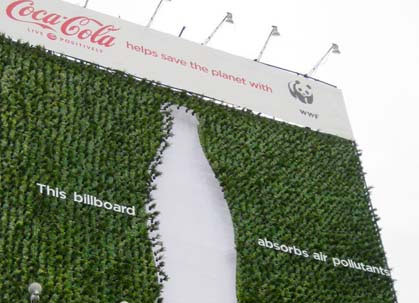

Folks around the sign business are all a-buzz with the latest green technology keywords: Recycled is a big one, so is LED. The cost savings and ecological benefits of these techniques are plain to see. Recently, however, a new truly green sign was unveiled by the Coca-Cola Company.
Measuing 60 feet by 60 feet, the billboard helps rid the environment of pollutants by using recycled materials to cradle thousands of Fukien tea plants which filter the ambient air around the sign. “This billboard helps alleviate air pollution within its proximate areas as it can absorb a total of 46,800 pounds of carbon dioxide from the atmosphere, on estimate.” says Botanish Anthony Gao. Each tea plant is capable of removing over 12 pounds of carbon dioxide in a year’s time. Of course, old Coke bottles were used as recycled planters for each of the 3600 plants.
Fed by drip irrigation, also known as micro-irrigation, the signage system utilizes a highly efficient watering system which also saves in needed fertilizer by allowing the water to slowly trickle down to the roots of the plants.
Now if only the energy produced by the Fukien tea plants could be used to power some LED lights, and shine the glory of eco-signmaking into the night, we would really be in green heaven. Until then, read the full story here, or call your friendly CNP Signs & Graphics representative for the next best thing to plant-powered signs.
Another Bright Idea – Sign Company Uses Green Lighting


As a sign manufacturer, CNP Signs & Graphics has had more than its share of bright ideas over the past 60 years. None of them, however, has been quite as illuminating as removing 207 light fixtures from their production floor this past month.
CNP Operations Manager Bob Lenzini explains the move as part of an SDG&E Energy Efficiency Business Incentives program to replace older fixtures. “For a total cost to the company of $373, we will save over $21,000 this year alone,” says Lenzini. How’s that for a great return on investment while going green and helping the environment?
CNP Signs & Graphics has several departments in their San Diego manufacturing facility including sheet metal, welding, painting, plastics, shipping and more. Each area had from half a dozen to several dozen of the old Magnetic ballast fixtures that took 96” inch fluorescent tubes. Those lights lit up the production floor from early morning until the last worker left late in the evening.
Today there are the same number of fixtures hanging above the work areas of CNP. However, the new fixtures are half the size of the old ones – at 4 feet, and they have a couple of other interesting features. The new ballasts are electronic and much more energy efficient. The bulbs for the new fixtures are T5. These replace the old T12.
Ever wonder what “T” stands for? Tubular. The number after the “T” is the size of the light measured in 8ths of an inch. So the T5 bulbs are much smaller, yet are 51% more efficient. They also produce a better quality of light. Measured in CRI (Color Rendering Index) the T12 produced about 62CRI, while the new T5 bulbs rated an astounding 85CRI. And the lumens? Forget about it. The T5 outshine the old T12 by 103 LPW (lumens per watt) to a mere 78 LPW.
Of course, as a sign company, this kind of technical data is right up our channel lettering, but Shop Foreman John Murphy put it a bit more clearly when he said “you’ve almost got to wear sunglasses out there.”
A final note on those smart lights – they have motion sensors to know when workers are in the area. No motion, no light – no light, lower electric bills. As Bob Lenzini says, “it’s great when making the company greener also makes it more profitable.”
